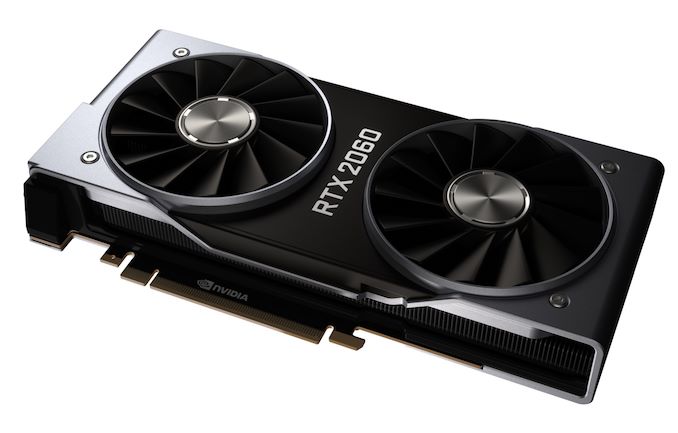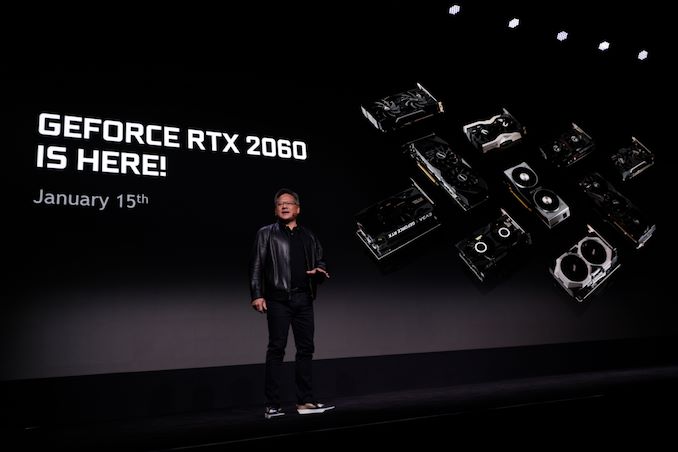The NVIDIA GeForce RTX 2060 6GB Founders Edition Review: Not Quite Mainstream
by Nate Oh on January 7, 2019 9:00 AM ESTClosing Thoughts
As we bring this to a close, we are again revisiting the central themes of the GeForce RTX 20 series across the launches: forward-looking featuresets that are not widely available, premium pricing based on those hardware features, and competition with existing Pascal products due to comparable conventional gaming performance. This time, however, the last two have played out a little differently. Pascal-based GTX 1080, 1070 Ti, and 1070s are not so readily available and/or are at higher prices. And although the price premium pushes the GeForce RTX 2060 (6GB) out of the traditional mainstream home of the x60 part, it puts it firmly in contention against the Radeon RX Vega cards and to a lesser extent the recently-launched Radeon RX 590.
As a whole, in developing Turing and the GeForce RTX 20 series, NVIDIA has invested heavily in hybrid rendering, offering less price-to-performance for conventional gaming than usual for new GPU architectures. This has been compounded by excess Pascal inventory, a result of the cryptocurrency mining demand of the past year or two. The RTX 2060 (6GB) is no exception, and while it is a better price-to-performance offering relative to its older siblings, it’s simply no longer a ‘mainstream’ video card at $350, instead occupying the ‘value-enthusiast’ space.
For conventional gaming, if the RTX 2080 is akin to the GTX 1080 Ti and the RTX 2070 like the GTX 1080, then the RTX 2060 (6GB) truly performs like the GTX 1070 Ti. By the numbers, the RTX 2060 (6GB) is 2-3% faster than the GTX 1070 Ti at 1440p and 1080p, though comparison becomes a wash at 4K. In turn, reference-to-reference the RTX 2060 (6GB) is around 11% faster than the RX Vega 56 at 1440p/1080p, narrowing to 8% at 4K. There are hints that the 6GB framebuffer might be limiting, especially with unexpectedly low 99th percentile framerates at Wolfenstein II in 4K, though nothing to the extent that older 4GB GTX 900 series cards have experienced.
Potential VRAM bottlenecks is something that needs further investigation, but more to the point, this is a $350 card featuring only 6GB VRAM. Now it is admittedly performing 14-15% ahead of the 8GB GTX 1070, a card that at MSRP was a relatively close $379, but it also means that NVIDIA has essentially regressed in VRAM capacity at this price point. In terms of the larger RTX lineup, 6GB is a bit more reasonable progression compared to the 8GB of the RTX 2070 and RTX 2080, but it is something to revisit if there are indeed lower-memory cut-down variants of the RTX 2060 on the way, or if games continue the historical path of always needing more framebuffer space. The biggest question here isn't whether it will impact the card right now, but whether 6GB will still be enough even a year down the line.
Generationally, the RTX 2060 (6GB) does bring more to the table, offering roughly 86% of the performance of the RTX 2070 for 70% of the price. Or against its direct predecessor, the GTX 1060 6GB, it’s faster by around 59%. In context, the GTX 1060 6GB was 80-85% faster than the GTX 960 (2GB) at launch, where presently that gap is more along the lines of 2X or more, with increased framebuffer the primary driver. But at $200, the GTX 960 was a true mainstream card, as was the GTX 1060 6GB at its $249 MSRP, despite the $299 Founders Edition pricing.
What makes the $350 pricing at least a bit more reasonable is its Radeon competition. Against RX Vega at its current prices the RTX 2060 (6GB) is near-lethal, so if AMD wants to keep their Vega cards as viable market competitors, they are going to have to reduce prices. Reference-to-reference, the RTX 2060 (6GB) is already bringing around 95% of RX Vega 64 performance, so card pricing will make all the difference. The same goes for the RX 590, whose position in the ‘performance gap’ between the RX Vega 56 and RX 580 is now shared. And alongside potential price changes, there are still the value-adds of game bundles and FreeSync compatibility.
At least, that would have been the straightforward case for AMD if not for yesterday’s announcement of game bundles for RTX cards, as well as ‘G-Sync Compatibility’, where NVIDIA cards will support VESA Adaptive Sync. That driver is due on the same day of the RTX 2060 (6GB) launch, and it could mean the eventual negation of AMD’s FreeSync ecosystem advantage.
Like the RTX 2070, the RTX 2060 (6GB) is less suited as an option for most high-end GTX 10 series owners, and with 6GB VRAM as it’s a little less tempting than it could be as a move up from the GTX 1060 6GB or GTX 980 Ti. The card offers known performance along the lines of the GTX 1070 Ti and at very similar power consumption, but brings better value than existing higher-end RTX 20 series models. And this time, there’s less of a spoiler effect from older Pascal models.
Compared to previous generations, it’s not breaking the price-to-performance curve, as it is still an RTX card and pulling double-duty as the new entry-point for RTX platform support. That being said, there is no mincing words about the continuing price creep of the past two GeForce series. The price-to-performance characteristics of the RTX 2070, 2080, and 2080 Ti is what renders the RTX 2060 (6GB) a better value in comparison, and not necessarily because it is great value in absolute terms. But as an upgrade from older mainstream cards, the RTX 2060 (6GB) price point is a lot more reasonable than the RTX 2070’s $500+, where there more of the price premium is from forward-looking hardware-accelerated features like realtime raytracing.
So the RTX 2060 (6GB) would be the most suitable for gamers that aren’t gung-ho early adopters or longtime enthusiasts. The caveat is on the 6GB framebuffer, keeping in mind that the 4GB GTX 980 and 970 now punch below their weight in certain games, given the trends of HDR, HD texture packs, high-refresh rates, and more. Beyond that, the RTX 2060 (6GB) and RTX 2070 comes with a choice of Anthem or Battlefield V, as part of the new bundle. For a prospective buyer, this might not justify $500 but might outweigh $350, especially as realtime raytracing can be immediately tried out with Battlefield V. In the same way, upcoming support for adaptive sync could do the same for those looking to upgrade to a monitor with variable refresh rate.













134 Comments
View All Comments
richough3 - Tuesday, January 8, 2019 - link
I would wait a few generations before I would purchase a video card for it's ray tracing abilities. The main reason I would buy any high end card is for FPS, because in competitive gaming, FPS is king, so any visual quality feature would be at minimum setting or turned off anyway.nunya112 - Tuesday, January 8, 2019 - link
AMD is about to have its best year for video cards mark my words!NVidia have launched a product that while on paper and technology wise is awesome. however. the physical hardware Is not capable to use that technology. im referring to RTX its too slow. And NV is asking a premium for it. NVidia has made AMD's job very easy.
all AMD hasto do is. provide good cards MUCH CHEAPER and they will own at least 50% of GPU market.
webdoctors - Tuesday, January 8, 2019 - link
Yo how much do you get paid to post? Can I do it too from home? We can split the referral bonus. Make me an offer, could use quick cash.nunya112 - Tuesday, January 8, 2019 - link
I bought a 580 8gb for 199 Australian just before Xmas. was because they all had excess supply again from all the miners. well we all know what happened there! It crashed faster than a meth head would on sunday afternoon after being up for 3 days. and they all had ROOMS full of video cards. knowing one of the bigger etailers boss personally. they had so much excess stock. they were going to throw out low end cards because they didnt have room for more expensive products in the warehouse! for instance they had 6 pallets of of gigabyte aurorus 580's and the next day 590's were being delivered. luckily when they dropped to $199AU a lot of ppl picked them up. they still made a profit.moral here is AMD needs to compete with NV for nothing. set their own low prices that they still make 15% on and spank NV
Sherlock - Tuesday, January 8, 2019 - link
Couple of points :1) Nvidia's strategy - which seems to have backfired - was to hope that RayTracing will take off in a big way - and put all its eggs in that basket. Nvidia added in specialized hardware to support RT, which has effectively priced it out of the mainstream market and has to add in "features" like DLSS to convince the consumer that they are getting a good deal @ $350 for what is essentially a 1080p class GPU - equivalent performance from the "traditional" GPU's is available ~$200
2) RayTracing will not take off until it is supported on the XBox and PS as a majority of the games are developed with those platforms in mind. Considering AMD is rumored (confirmed??) to supply the CPU/GPU for the next-gen consoles - unless AMD starts supporting RayTracing this gen - Nvidia has essentially wasted hardware resources and consumer money on something that is completely useless. By the time we have software that uses RT in a meaningful way - these Nvidia cards will be redundant
nunya112 - Wednesday, January 9, 2019 - link
it wont take off because the current hardware can not run it very well. its good on paper, and great to show. but this should have been released next year with a faster chip. because when RTX is on FPS hits so low.CiccioB - Wednesday, January 9, 2019 - link
Next year, with the right HW, nvidia wll have all developers ready to create optimized RT games (unlike BF5). You just look a the finger, not what it it point at.And if the weapon in AMD hands is slowing the technological progress because they have the monopoly in the console market, well, let me say it, I hope that AMD will die soon.
saiga6360 - Wednesday, January 9, 2019 - link
Foolish. If you think nvidia can bring ray tracing to the masses by its lonesome, then you are dreaming. They have to charge you hundreds and thousands just for that finger as you call it, that must be the middle finger because it's not going to get the point across. Just for anything to become a standard, be it 2K, 4K, adaptive sync, it needs to be affordable and for that to happen AMD and Intel needs to get on board.808Hilo - Friday, January 11, 2019 - link
Nvidia marketing fantasy to counter another nonsensical product...580. Just build one top card and sell many. Then build another one. As it seems we are stuck on 1080 performance four years in a row. Lame.Ravenmaster - Saturday, January 12, 2019 - link
It's a 1070Ti